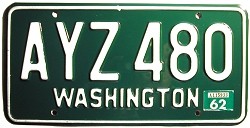
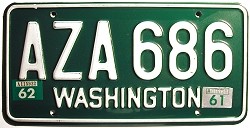
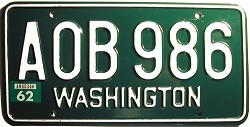
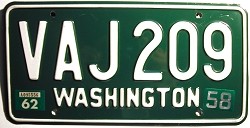
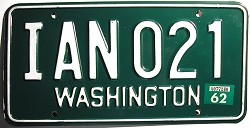
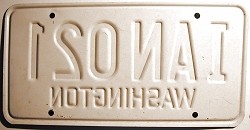
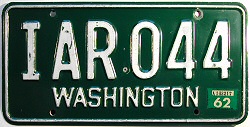
 |
First type issued, beginning in 1958, with the common 1958-style WASHINGTON die. This die was used for plates AAA 000 through AYZ 999. King County renewal stickers from 1959 through 1968 have serial numbers starting with the letter "A". | |
 |
Second type issued, with the less common 1962-style WASHINGTON die. Notice the more pointed "A" and larger letters. This die was used for all plates starting with AZA 000. | |
 |
In 1961, King County reached plate AZZ 999. Earlier in the series, however, no plates were ever made that used I, O, or Q in the serial. To extend the supply of A plates, the DMV ordered a batch of plates with the letter "O" in the middle position. About 23,000 sets were issued, running from AOA 000 through AOZ 999 (AOI, AOO, and AOQ were skipped). This supply lasted until early-mid 1962. | |
 |
The supply of AOx series plates was nearly exhausted in early 1962, so King County ordered another batch (in the IAA series). While the new plates were being manufactured, however, the county needed borrow plates from other counties to meet the demand for registrations. King County is known to have borrowed from Kitsap, Stevens, and Pacific counties, and possibly from others. These plates can be distinguished from those actually issued in their respective counties because the King County plates all have a 62 sticker bearing a letter "A" prefix in the serial number. The pictured plate was taken from Pacific County, and has sticker #A095556. | |
 |
In mid-1962, King County received a shipment of 15-20,000 pairs of passenger plates beginning with number IAA 000. The reason for switching to the "I" series rather than sticking to the "A" prefix with I or Q in the second letter position is not known. The I series plates were manufactured during the same time that the new 1963 baseplates were being produced. For this reason, all "I" prefix issues are white on the back side, instead of the usual green (the penitentiary plate factory used white 1963 baseplate blanks). |  |
 |
The highest verified plate numbers are from the IAR series. |
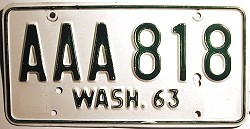 |
King County plates on the 1963 base started with plate number AAA 000. Statewide, there were two types of dies used for the "WASH. 63" legend, and some counties used both styles. King County, however, only used the 'round date' variety, and never issued any 63 bases with the 'squared' date. The 1963 base plates continued through AZA 999. Roughly, AAA through the early ARx series were issued in 1963, early ARx through early AYx in 1964, and the rest of the AYx through the AZA series came out in 1965 (all were dated 63). There is, of course, some flexibility to these blocs, as plates were sold from different areas in the county, so they were not necessarily issued sequentially. |
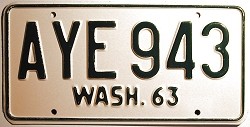 |
During 1963, motorists were in an uproar over the shortened state name, believing that "WASH" was not a very dignified abbreviation. The legislature responded in 1964 with a law stating that as of January 1, 1965, all new passenger plates manufactured must bear the state name in full. Existing plates would remain valid, and the supply of WASH plates were to be issued as long as they were still in stock. Some of the smaller counties (Asotin, Columbia, Douglas, Ferry, and others -- about 12 in all) never ran out of 1963 bases, and continued to issue the "WASH. 63" plates through the end of 1967. King County, as the most populous in the state, used up its '63 bases in early 1965. The '63 plate shown, from the AYE series, would have been issued in late 1964 with a white-on-green 64 sticker. |
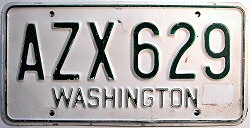 |
Beginning in January 1965, a state law went into effect prohibiting the use of the abbreviation "WASH" on newly manufactured Washington passenger license plates. King County's new "WASHINGTON" baseplates began to appear in the first quarter of 1965, with letter combinations starting with AZB 000. As with the initial run of 1958 baseplates, the letters I, O, and Q were omitted from the second and third positions on the '63 bases. |
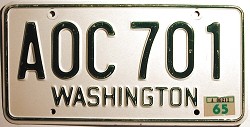 |
When AZZ was reached in early-mid 1965, plates were issued with O in the second letter position, then with I in the second position, then with Q. Next, "A" series plates were issued with O in the third position, then I, then Q. This lasted into 1966. |
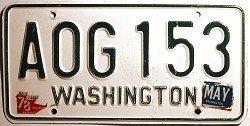 |
Although the majority of 1965 bases used the "WASHINGTON" die with the pointed A (as was used on late-issue 1961 and 1962 King County plates), a few in the AOx series were manufactured with the older 1958-style "flat-top A" die, as can be seen in the picture at left. This die type is verified from AOF through AOL (and appeared on a few Spokane County plates in the late CGx series). |
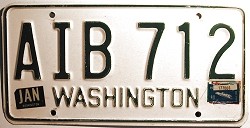 |
Plates with "I" in the second letter position were issued after AOZ was reached, starting with AIA, AIB, AIC, etc. Also notice on this and subsequent plates that there is a larger space between the letters and numbers. Plates AOC 701 and AOG 153, shown above, have a narrow space between the letters and numbers that was characteristic of the '58 and '63 baseplates. Starting around the AON series, the space was widened, probably to improve legibility. |
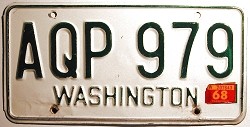 |
Plates with "Q" in the second letter position were issued after AIZ was reached, starting with AQA, AQB, AQC, etc. (early 1966). |
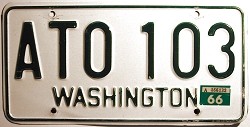 |
After AQZ was reached, plates were issued with "O" in the third position, starting with AAO, ABO, ACO, etc. (early 1966). |
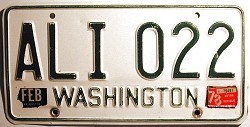 |
After AZO was made, plates were issued with "I" in the third position, starting with AAI. Subsequenty, plates were issued with "Q" in the third position (not shown), which were exhausted in mid-1966 when number AZQ 999 was reached. |
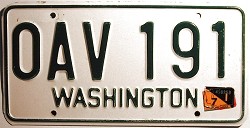 |
In mid-1966, AZQ 999 was reached in King County and a new series of plates began to appear that started with the letter "O". The O series was still in progress when the 1965 style baseplates were discontinued at the end of 1967 (highest issued on this base was in the OEZ series). |
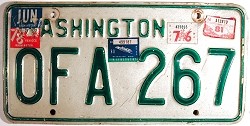 |
Beginning January 1, 1968, every new passenger license plate issued statewide was required to be fully reflective, although the non-reflective plates already in use were not required to be replaced. Any unissued painted, non-reflective passenger plates, however, had to be scrapped at the end of 1967. In some cases, the serial numbers of the plates that were destroyed were remanufactured for issue on reflective 1968-style bases. Non-passenger types were allowed to be issued until existing stocks were exhausted (which occurred during 1968 for most types). King County license plates on the 1968 base started at number OFA 000. Some of the earliest plates issued in 1968 (statewide) were made from leftover white-painted blanks, and thus are white on the reverse side. Others were made on bare aluminum, and have no paint on the back side. | 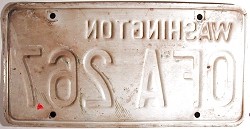 |
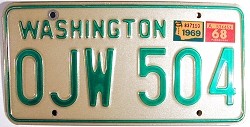 |
This 1968 King County baseplate is of the variety with a bare metal back. White back plates in this county can be found on most plates from OFA through the late OHx series. Everything made from OJA onward seems to have an unpainted metal back. | 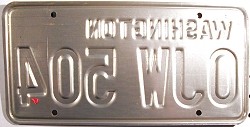 |
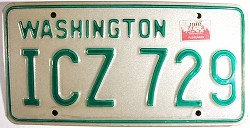 |
In November 1972 the "O" series was exhausted when plate OZZ 999 was reached, and new plates for King County began to appear in the IAA series. Notes: The "I" series skipped the range of ISA through ITZ, which was set aside for Island County. The 2,000 plates from IVA 000 through IVB 999 were actually issued from Spokane County in 1978, for uncertain reasons (possibly because Spokane was running out of "C" plates at the time). IZZ was reached in late 1978. | |
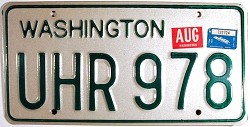 |
After the "I" series was exhausted around October-November 1978, King County began a new series at UCA 000. UAA through UBZ were reserved for use by Okanogan County. The last county-coded plates issued in King County were UKZ 999, in May 1980. |
| All material © 2003 by Ian Slade. Please do not reproduce any content without written consent of the owner. |